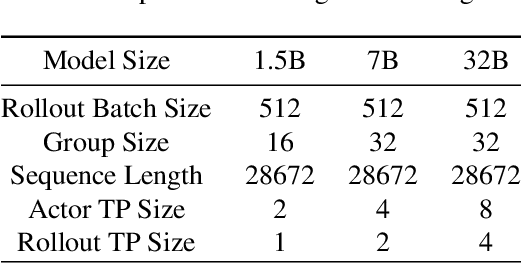Hongzhi Zang
RLinf: Flexible and Efficient Large-scale Reinforcement Learning via Macro-to-Micro Flow Transformation
Sep 19, 2025



Abstract:Reinforcement learning (RL) has demonstrated immense potential in advancing artificial general intelligence, agentic intelligence, and embodied intelligence. However, the inherent heterogeneity and dynamicity of RL workflows often lead to low hardware utilization and slow training on existing systems. In this paper, we present RLinf, a high-performance RL training system based on our key observation that the major roadblock to efficient RL training lies in system flexibility. To maximize flexibility and efficiency, RLinf is built atop a novel RL system design paradigm called macro-to-micro flow transformation (M2Flow), which automatically breaks down high-level, easy-to-compose RL workflows at both the temporal and spatial dimensions, and recomposes them into optimized execution flows. Supported by RLinf worker's adaptive communication capability, we devise context switching and elastic pipelining to realize M2Flow transformation, and a profiling-guided scheduling policy to generate optimal execution plans. Extensive evaluations on both reasoning RL and embodied RL tasks demonstrate that RLinf consistently outperforms state-of-the-art systems, achieving 1.1x-2.13x speedup in end-to-end training throughput.
Multi-UAV Behavior-based Formation with Static and Dynamic Obstacles Avoidance via Reinforcement Learning
Oct 24, 2024



Abstract:Formation control of multiple Unmanned Aerial Vehicles (UAVs) is vital for practical applications. This paper tackles the task of behavior-based UAV formation while avoiding static and dynamic obstacles during directed flight. We present a two-stage reinforcement learning (RL) training pipeline to tackle the challenge of multi-objective optimization, large exploration spaces, and the sim-to-real gap. The first stage searches in a simplified scenario for a linear utility function that balances all task objectives simultaneously, whereas the second stage applies the utility function in complex scenarios, utilizing curriculum learning to navigate large exploration spaces. Additionally, we apply an attention-based observation encoder to enhance formation maintenance and manage varying obstacle quantity. Experiments in simulation and real world demonstrate that our method outperforms planning-based and RL-based baselines regarding collision-free rate and formation maintenance in scenarios with static, dynamic, and mixed obstacles.
 Add to Chrome
Add to Chrome Add to Firefox
Add to Firefox Add to Edge
Add to Edge